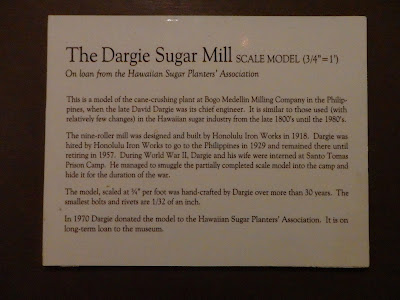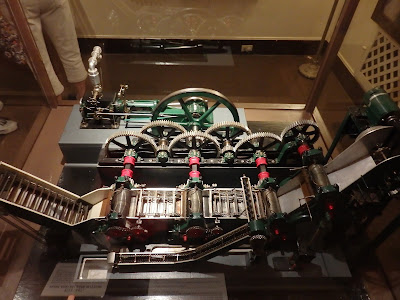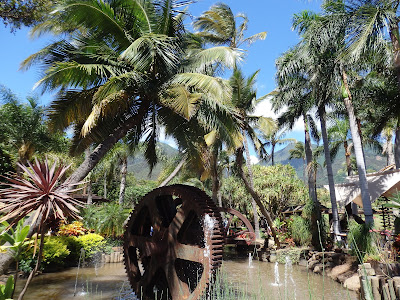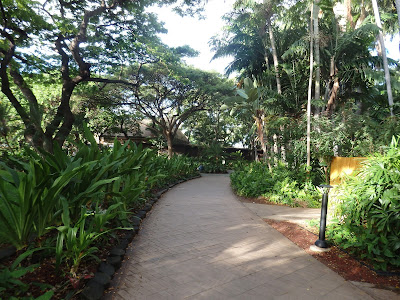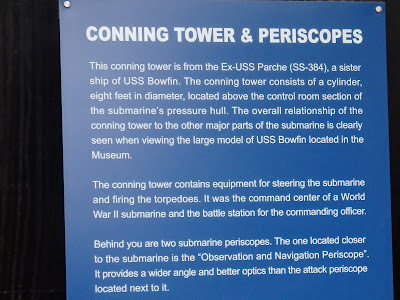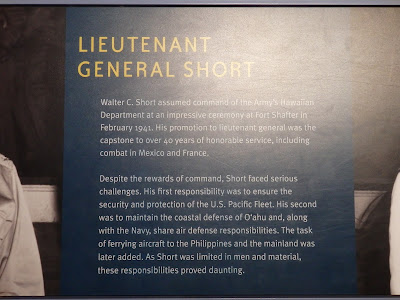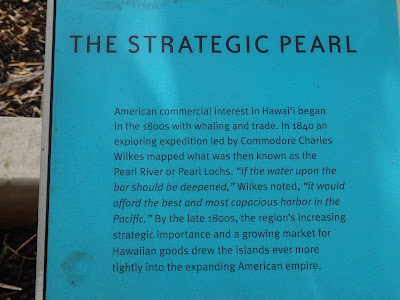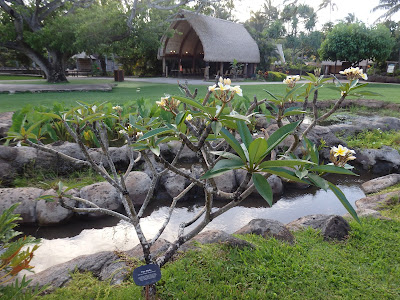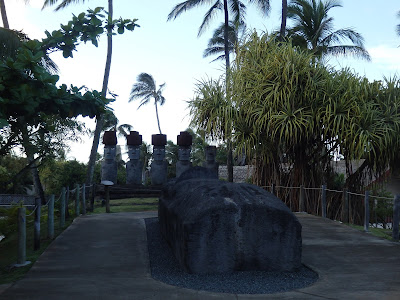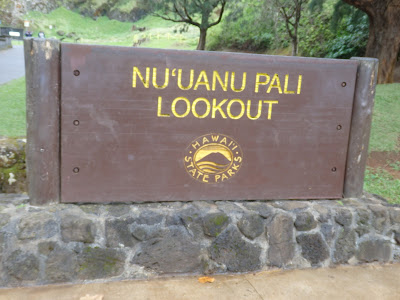 |
| Decided to quit full-time RVing after twelve years. Truck sold January 2017, Trailer sold April 2017. Still plan to travel, so check back from time to time to see what we are doing. |
Saturday, May 20, 2017
Lifestyle Change
Hawai'i Vacation
 |
| We spent one night at the Waikiki Beach Marriott. From our balcony we could see Waikiki Beach. |
 |
| Looking toward the Ko'olau Range This mountain range is actually an ancient shield volcano that is one of the oldest parts of Oahu at roughly 2.5 million years old |
 |
| Honolulu has lots of murals. Pow Wow Hawaii brings high-profile local, mainland and international artists to a neighborhood called Kakaako each February to produce more murals. |
 |
| We saw lots of homeless in Honolulu but none begging on the corners. Instead, volunteers are out begging for the homeless. |
 |
| Our first view of the Norwegian Cruise Line Pride of America. It's the largest American-based cruise ship and the one that offers the longest cruise of the Hawaiian islands. |
 |
| Time to get off the bus and start the process of boarding the ship. |
 |
| Long lines coming in from both directions for the first check of our ID's. |
 |
| Once on board our cabin wasn't ready so we climbed to the highest part of the ship that was open to us to survey our surroundings. |
 |
| High rises continue outside of the downtown area all the way to Diamond Head. Some were quite interesting. |
 |
| Looking aft. |
 |
| Upon closer inspection, there were some interesting boats in the harbor. |
 |
| Tug boats headed in and out to assist large ships. |
 |
| The refueling ship came alongside to refill the tanks. |
 |
| As darkness fell, the Pride of America (POA) pushed back from the dock under its own power. It did a "U" turn in the harbor to get its bow pointed out to sea. |
 |
| The same dock area handled a lot of freight. |
 |
| This ship was being unloaded. |
 |
| Saw a couple crew members playing basketball forward of the housing tower at the rear of the ship. |
 |
| A sightseeing boat was coming in as we were leaving. Diamond Head, locally know as Lēʻahi, dominates the point at the end of Waikiki Beach. |
 |
| There was a light tower at Honolulu Harbor |
 |
| The first day Nolan noticed that the sign by our cabin door could be changed. The follow photos show the different phrases. |
 |
| Our cabin was an interior made up with two twin beds. These could have been pushed together to create a king and there were two bunks that could have been pulled down. |
 |
| We had a desk with a stool on one side and a TV, drawers and shelves on the other. Behind the corner mirror is the restroom. The other side was a closet and a refrigerator behind the TV. |
 |
| You can always click on the photo to enlarge it for reading. |
 |
| Some of the signage has not been updated. The last sentence is wrong. |
 |
| Key to map in next photo |
 |
| Sugar cane |
 |
| The building housing the museum is formerly the factory superintendent's home. |
 |
| Once cut the sugar cane was loaded onto trucks using this grabber |
 |
| The last operating sugar mill on Maui is located across the street from the museum. |
 |
| During the bus ride to the Maui Plantation we went past a field of sunflowers being grown for biofuel. The locals had never seen sunflowers before so they were out in the fields checking it out. |
 |
| All the cars parked along the road presented a hazardous situation. I wonder how many of the sunflowers were picked and taken home. |
 |
| The West Maui Mountains. |
 |
| I had taken care of some of these tropical plants before but I never knew bromiliads came in so many colors. The pineapple plant is a type of bromeliad! |
 |
| Just look at how these palms fan out! I'd never seen anything like this. They call them Traveler's Palms. |
 |
| Look at that ring of fruit stems lower on this palm... interesting. |
 |
| So these are pineapple plants... that's right, pineapples don't grow on trees. Click on the photo to enlarge it so you can see the pineapples on their stalks. |
 |
| I laughed when I saw these flowers because I finally understood why one of the shirts I order for work comes in a color called heliconia. These are heliconia plants. What beautiful flowers! |
 |
| I'd never heard of jackfruit before |
 |
| We stopped the tram for a coconut husking demonstration. This gal struck the coconut on a pick that was mounted to the stump table. |
 |
| After getting off the husk, she showed us that all coconuts have a face. |
 |
| Coconuts are self-propogating. |
 |
| Mangos |
 |
| I took care of Norfolk pines once upon a time. They were introduced to the Hawaiian Island by Captain Cook because they made great ship masts. |
 |
| Chenille plant |
 |
| I want to call this a dracaena marginata but I'm not sure it is. Maybe it's a variegated variety of the hala tree. More on them later |
 |
| Ok, I'm no ornithologist but this might be a black-crowned night heron. Doesn't look like any heron I've ever seen before. |
 |
| View of the West Maui Mountains from the Maui Plantation gardens. |
 |
| Another unmarked plant but I think it is a Blue Jade vine. |
 |
| Closer photos of the blue jade vine flowers. |
 |
| Heliconia come in many varieties and colors. These are lobster claw heliconia. |
 |
| Sighting of our ship in the harbor. |
 |
| Day 3: Getting onto the whale watching boat at Maalaea Harbor |
 |
| Wind turbines on western Maui coast |
 |
| West side of the Western Maui Mountains |
 |
| The mama did one huge jump but the baby was jumping all the time. |
 |
| When we got back to the ship, a walk along the promenade deck showed us they were getting the tenders ready for use. |
 |
| Towel rabbit |
 |
| When you look at photos of Rainbow Falls online, they have only about half the water falling as we saw this rainy day. Yes it was raining and I worked hard not to get drops on the camera lens. |
 |
| We climbed up to the upper lookout. Just look at those huge pothos climbing the tree! Sunscape has a pothos in the Welcome Center. |
 |
| Next stop on the bus tour was a stop at Hilo's statue to King Kamehameha. King Kamehameha I was the founder and first ruler of the Kingdom of Hawaii. He united the islands. |
 |
| Interesting pedestrian bridge in the park where the statue was located. |
 |
| The beach?? at Reeds Bay Beach Park was covered in broken corals. This park is along Banyan tree drive where celebrities and big wigs have planted banyan trees through the years. |
 |
| Nolan modeling his rain poncho by a big Banyan tree |
 |
| You can barely see the POA through the rain |
 |
| Other side of the Banyan tree... oops the camera lens is fogging. |
 |
| Palms along Banyan Tree Drive. |
 |
| Saffron finch |
 |
| Turtle sighting at Richardson Black Sand Beach Park |
 |
| The turtle didn't move so we wondered if it was even alive. |
 |
| The black sand beach looked like mud. |
 |
| Interesting leaning tree at the bus stop. |
 |
| Looks like a pig to me. |
 |
| The evenings entertainment was a sail by the spot where lava from Kilauea Volcano pours into the ocean. |
 |
| We were a mile from it so it was very difficult to get a photo while the ship was moving with the waves. |
 |
| Day 5: POA anchored in Kona Harbor. |
 |
| UFO on the water |
 |
| Water driveway to Paul Allen's home, billionaire owner of a few sports teams. |
 |
| Time to look beneath the waves. We're going down in the Atlantis submarine. |
 |
| One last look at the beauty of Kona Harbor before we sink beneath the surface. |
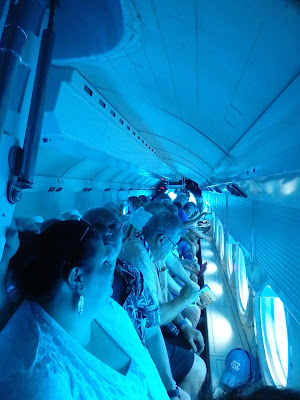 |
| Can't remember how many people got on the ship but it was tight quarters. Our seat was actually not in place until after the ladder was raised. |
 |
| We could have purchased a brochure that pictured all the fish we might see but they had these displays on the sub. |
 |
| Maybe a Pinktailed Triggerfish....maybe |
 |
| Troop transport on the bottom purposely sunk in Kona Harbor |
 |
| Ay Captain.. looks like a skeleton on the yardarm! Yes a fake skeleton was strapped to the wreck. |
 |
| Local divers dressed the skeleton for every holiday but that ended when some kids started crying because Santa Claus was dead. |
 |
| I did some research when posting this photo and found out it is a WWII Landing Craft called the Predator. |
 |
| The Firestone Garden... tires are used as bumpers and they fall off all the time. We saw lots of them. |
 |
| The depth gauge at the lowest point we went. The pilot set the sub on the bay floor for a short time. |
 |
| Blowing the air tanks as we rise. |
 |
| Waving goodbye to the sub captain and crew. |
 |
| Towel rabbit |
 |
| Day 6: We took an all day shore excursion around the island of Kaua'i, the oldest and most northerly of the Hawaiian Islands. |
 |
| First stop was at the Wailua River boat dock. |
 |
| Nounou Mountain (Sleeping Giant) from Wailua River Marina. |
 |
| Kayakers on the Wailua River, Hawai'i's only navigable river. |
 |
| Our destination was Kauai's famous fern grotto. |
 |
| The Fern Grotto. Lots of weddings are held here. |
 |
| Found some kukui nuts growing at the grotto. |
 |
| Kukui nut lei I made during one of the lei making classes during the cruise. |
 |
| So here's that interesting boat. See how the motor is in a separate boat that is attached to the passenger section? |
 |
| Fern Grotto boat dock |
 |
| Our tour route. We started at Nawiliwili Harbor, where the POA was docked to our first stop at the Fern Grotto on the Wailua River. Next stop Opaekaa Falls. |
 |
| Opaekaa Falls |
 |
| Hala tree growing at the rest stop. Although the fruit kinda look like pineapple, this isn't a pineapple tree because no such thing exists. |
 |
| Fruit of the hala tree. |
 |
| We walked across a road, read this sign then looked up... |
 |
| where we were overlooking a section of the Wailua River that we had just navigated in a boat. |
 |
| Crossing back over the road, this sign gave me a chuckle. |
 |
| Next stop, Spouting Horn Park. |
 |
| This blowhole had water spouting up a good twenty feet but the waves must not have been right for the 50' it can supposedly rise. |
 |
| The ever present chickens roam the park that is circled by vendors. |
 |
| My favorite part was where the waves crashed onto the rocks. |
 |
| I saw more chickens on Kaua'i than any of the other islands. |
 |
| Kauai Soto Zen Temple Zenshuji (Buddist Temple) in Hanapepe, Kauai, HI |
 |
| Waimea Canyon, commonly called the Grand Canyon of the Pacific. |
 |
| I had to zoom in to see that there were two and didn't know it until I looked at the photos. |
 |
| This rooster was a real poser. |
 |
| I saw something on a ridge and wondered what it was so I zoomed in. That almost looks like someone carved a face but I couldn't tell if it was natural or man-made. |
 |
| I zoomed out a little so you could see .... |
 |
| how far away I really was from this "face". |
 |
| The cocks were hanging out by the men's restroom... LOL |
 |
| So we headed back down the mountain. Beach along Waimea Bay at Waimea |
 |
| A pupu factory... Ok, so pupu is really appetizers. You might order a pupu platter which would consist of an assortment of small meat and seafood appetizers. |
 |
| Back in our room a towel elephant awaited our return. |
 |
| Looking at the shore from the ship, you can see just how serious Hawaiian's are about their solar panels. Too bad Arizona doesn't utilize this resource like Hawaii. |
 |
| Towel seal |
 |
| What the promenade deck looked like with the tenders and lifeboats stowed overhead. |
 |
| Powering around the island of Kauai to get to the Na Pali coast. |
 |
| Their balcony rooms were much bigger than ours. We didn't have a couch. |
 |
| Their cabin steward had made different animals for them. This is their pool towel made into a snake. |
 |
| And a washcloth mouse. |
 |
| The port side got to see the coast first but the ship turned and headed back the other way so we could get a look too. The fog was dense so it was hard to see. |
 |
| Finally the fog let up a little but I can't imagine how pretty the coast would be with the sun shining on it. |
 |
| There's a smaller island, which we couldn't see, somewhere off the coast of Kauai. |
 |
| Enjoying our friend's balcony |
 |
| Day 7: We departed the ship in the morning. Instead of waiting for our rooms to be ready at the hotel, five of us headed out to hike up Diamond Head. We took a taxi to the inside of the crater. |
 |
| That's where we are going! |
 |
| And we're off to the top! |
 |
| You can see there's a crowd at the top. |
 |
| Nolan and Robyn on one of the many switchbacks. |
 |
| Still headed up. |
 |
| Three layers of hikers |
 |
| A lot of the trail was very uneven and we even had to skirt some puddles. |
 |
| See the hole in the crater wall? Well that's the start of a long, dark, narrow tunnel that follows a steep set of stairs. |
 |
| We took a rest before attempting the steps. As we rested, we thought we saw some people we knew on the trail below. |
 |
| Yep, that's our friends taking a rest. |
 |
| Did I also mention the tunnel had a low ceiling in some places? |
 |
| I made it to the end of the tunnel! |
 |
| But the next part is 99 steep steps! |
 |
| Then we did a short tunnel which lead to a spiral staircase to the |
 |
| Getting to the exterior necessitated an undignified crouch or a crawl. |
 |
| Once out we weren't at the top but we were starting to get the view. We continued to the top |
 |
| The concrete pad people are standing on is actually outside the fence. |
 |
| Diamond Head Light |
 |
| Honolulu |
 |
| We made it to the top! |
 |
| Time for the descent. |
 |
| Koko Head |
 |
| The park headquarters is in the bowl of the crater. Cars enter through the tunnel in the opposite crater wall. |
 |
| What it looked like without zooming in |
 |
| Looking across the crater, you can see how Honolulu creeps up the slops of the Ko'olau Range. |
 |
| Now that looks like a steep road! |
 |
| Resting at the end of a long hike. |
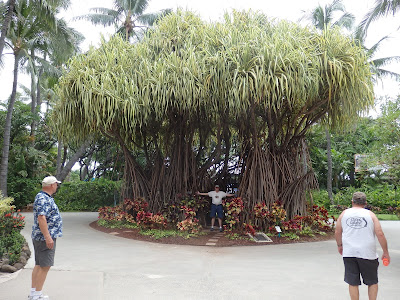 |
| Our room still wasn't ready when we got back to the hotel so we headed off to the snack bar for a bite to eat. Saw this amazing grove of hala trees so Nolan had to pose. |
 |
| We stayed three nights at the Hale Koa, a military hotel on Waikiki Beach. |
 |
| Our room was spacious and had a balcony. |
 |
| The following photos are from the Hale Koa grounds. |
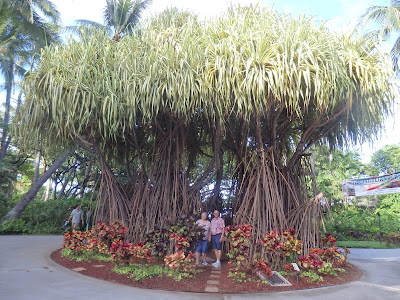 |
| Friends posing in the hala tree grove |
 |
| The lobby is open to the elements on each side. |
 |
| The drive circled this pergola covered water feature |
 |
| From the water feature looking across the drive to the lobby |
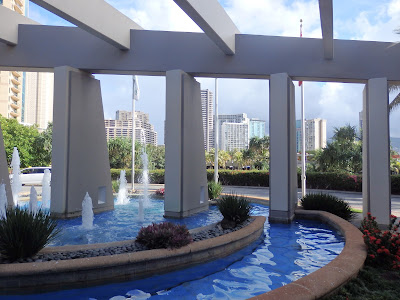 |
| Looking from the water feature out to the city |
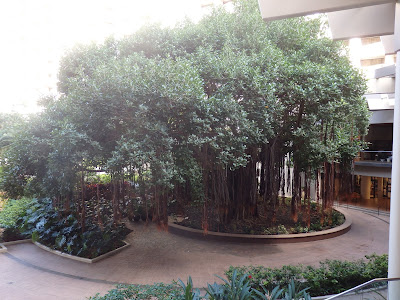 |
| This large banyan tree was on the opposite side of the lobby at the start of the gardens. |
 |
| Looking from the lobby to the start of the gardens |
 |
| The weather had cleared by the time we got to Pearl Harbor. |
 |
| There was information on each of the 52 lost submarines. Their life spans were incredibly short. |
 | |
I could see the Arizona Memorial from the submarine memorial |
 |
| There were two building full of information about the bombing of Pearl Harbor and the events leading up to it. |
 |
| I saw this bird when I was walking between museums. It's a common myna. |
 |
| We took the ferry out to the USS Arizona Memorial. This was the mooring for the USS Nevada |
 |
| This graphic shows the portions of the Arizona that show when the tides are out. |
 |
| The funnel (smokestack) was the only thing out of the water whe we were there. |
 |
| This is a photo of a urn containing the ashes of an Arizona survivor being returned to the Arizona. |
 |
| The USS Missouri. |
 |
| The U.S. flag flying above the Arizona Memorial |
 |
| Getting back on the ferry |
 |
| Looking back at the memorial |
 |
| We got back on the bus and continued out tour of Honolulu. This is the state capitol building. This is where the legislative and executive branches work. |
 |
| The statue is of Father Damien, a Roman Catholic priest who died in 1869 after sixteen years of serving patients afflicted with leprosy. |
 |
| The disc is the seal of the state of Hawaii. |
 |
| Side view of the ʻIolani Palace |
 |
| The ʻIolani Palace was the royal residence of the rulers of the Kingdom of Hawaii beginning with Kamehameha III in 1845 and ending with Queen Liliʻuokalani in 1893. |
 |
| Statue of King Kamehameha I that you see in the intro to Hawaii 5-0. |
 |
| Back at the Hale Koa we took a walk along Waikiki Beach |
 |
| The beach surrounded this lagoon where children could swim safely and learn paddle boarding. |
 |
| Little crabs running everywhere at the Ala Wai Boat Harbor |
 |
| Just look at the whale tail protruding from the roof of this bus |
 |
| Day two in Honolulu was the day we boarded a bus for a trip to the Polynesian Cultural Center. We saw this mural at one of the pickup locations. |
 |
| Mokolii, aka Chinaman's Hat Island |
 |
| A clearer and closer view. |
 |
| First we took a canoe ride on the lagoon to the opposite side of the park. |
 |
| Watch out for falling coconuts. Yes they can kill. A few deaths occur every year around the world from falling coconuts. |
 |
| Another posing bird |
 |
| In each of the eight simulated tropical villages, performers demonstrate various dances and crafts from the represented Polynesian culture. |
 |
| I believe this is Tonga |
 |
| Next we were off to Aotearoa aka New Zealand |
 |
| Although this is a welcoming performance, the dancers do their best to look fierce. |
 |
| Aotearoa |
 |
| Samoa. |
 |
| All part of the performance, I know but the guys rocked the canoe so violently that the poler fell off. All you can see is his foot sticking up in the air |
 |
| With this canoe from Fiji, you can really see that the performers aren't usually from the culture they are representing. |
 |
| The Hawai'ian canoe |
 |
| Tonga |
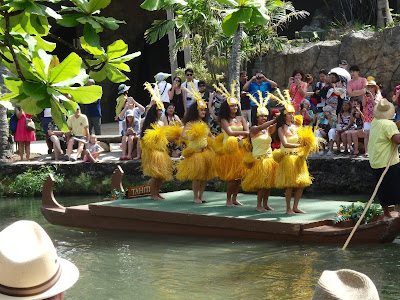 |
| The only male on the Tahitian canoe was the poler. |
 |
| Then we sat down for the luau |
 |
| Some of the pork for the meal was cooked in the ground, supposedly. I say that because there was another luau immediately following ours and there was only one cooking pit. |
 |
| Presentation of the royal court |
 |
| Quite an outfit. |
 |
| They had everyone having an anniversary during April go up on stage. We didn't tell them ours was coming up in a few days. LOL |
 |
| Our friend's anniversaries aren't in April but the whole trip was to celebrate the 50th wedding anniversaries of these two couples |
 |
| After the luau we caught another island presentation where three guys climbed a palm tree. |
 |
| Once they were all up the tree, they pretended that the guy on top was going to jump from that tree to a nearby one... didn't happen. |
 |
| The island presentations ended at 5 p.m. but the Hā: Breath of Life show at 7 pm. We wondered the park and took photos of the various cultures represented. |
 |
| Red-crested cardinal |
 |
| How ancient Polynesians managed to navigate between the islands. |
 |
| We saw a lot of trees wrapped in palm frond. Don't know the reason. Maybe to keep people from climbing them. |
 |
| Oh got distracted by a red-headed Cardinal... only problem was the camera focus on the edge of the roof instead of the cardinal. Bummers. |
 |
| I found some displays that gave more information on each culture. Click to enlarge for reading |
 |
| The shaka is a friendly gesture often associated with Hawaii and surfing. |
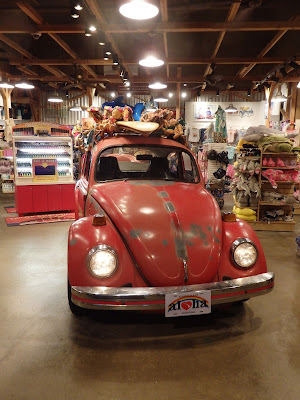 |
| This VW was in a shop at the center. |
 |
| Next we were on to the evening show. |
 |
| Our last day in Hawaii we did a bus trip to the North Shore. We stopped at the Dole Plantation. Nothing more than a store. |
 |
| I had wanted to see some of these trees while we were in Hawaii but thought it wasn't going to happen. These are Rainbow Eucalyptus |
 |
| Peel off a piece of bark and you get a different color. |
 |
| Pineapple field |
 |
| Sea turtle resting on the beach at Hale'iwa Beach Park. |
 |
| Doing our best shakas |
 |
| Sunset Beach Park favorite surfing spot on the North Shore of Oahu |
 |
| One of those wild chickens with it's chicken nuggets following along |
 |
| Stopped at a produce stand. It's just a little different from what we are used to as they have apple bananas, coconut, pineapple, mangos and other tropical fruits and nuts. |
 |
| We stopped at the Kualoa Ranch Gift Shop/Café for lunch |
 |
| There were some baby mongoose scampering around and this one trying to take a nap... not to successfully once the tourists found him. |
 |
| We stopped again at the Macadamia Nut Outlet. Just another place to shop but the scenery was nice. |
 |
| View behind the nut outlet. |
 |
| Interesting how the flowers are along the branches instead of at the end. |
 |
| Red ginger |
 |
| Looks like the flowers have flowers. |
 |
| Poi Factory. We didn't even try poi |
 |
| A local landmark, the Hygienic Store in Kahaluu, HI began life as the company store of the Hygienic Dairy. |
Subscribe to:
Posts (Atom)
























































